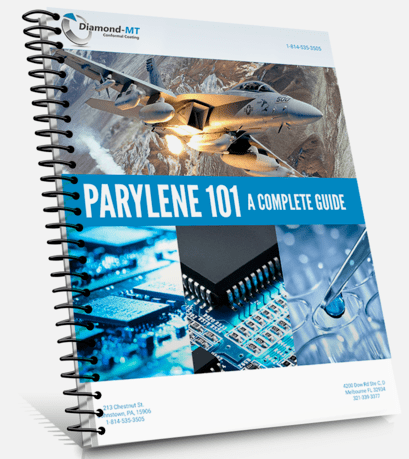Parylene and acrylic resins are both conformal coatings. Most of the similarities stop there. Because their properties vary so much, they have their own unique uses and capabilities.
Acrylic conformal coatings are a liquid conformal coating and can be applied four ways: spray, dip, brush, or robotics. Which method selected will vary by a couple of factors including: Quantity of products, complexity of masking requirements, and skill level of operators. They are usually applied between .002" and .005".
Parylene coating is applied through a vapor deposition process onto the substrate or material that is being coated. Depending on the coating type and required thickness, typical parylene deposition rates are about .2/mils per hour, so machine runs can vary from as little as 1 hour to over 24 hours. The process begins with raw dimer in solid state (these are: Parylene C, Parylene N, Parylene D, Parylene AF-4, or other variants) being placed into a loading boat, which is then inserted into the vaporizer. The parylene raw dimer is heated between 100-150º C. At this time, the vapor is pulled, under vacuum into the furnace and heated to very high temperatures which allows for sublimation and the splitting of the molecule into a monomer. The monomer gas continues to be drawn by vacuum one molecule at a time onto the desired substrate at ambient temperatures in the coating chamber. The final stage of the parylene deposition process is the cold trap. The cold trap is cooled to between -90º and -120º C and is responsible for removing all residual parylene materials pulled through the coating chamber. As you can see, the application process of parylene is quite different than a traditional wet chemistry coating like acrylics.
Parylene films are usually applied between .0005" and .002", but can be applied as little as .0001".
A common use of acrylics is on printed circuit boards for moisture protection.
While parylene can be used on printed circuit boards, it has a wide range of uses in medical products such as stents, catheters, and needles.
While there are some parylene disadvantages, it also has significant advantages. Automatically disqualifying parylene for consideration would be like disqualifying any other coating for parylene. Ultimately, different coatings are suited to different products. Considering all of the options for all of your projects can help your company find the right coating for every project, whether it ends up being parylene, acrylic, epoxy or polyurethane.

In applications that have an exposure to solvents, acrylic conformal coating is not the best choice. Acrylic conformal coating can be removed with a weaker solvent such as isopropyl alcohol or xylene. Whenever it faces even stronger solvents, it will not offer the protection that is needed, especially if your product is a mission critical device.
For products that require a high temperature application, acrylic coatings will fall short of expectations. For HumiSeal 1B31, arguably the most popular acrylic coating, the max continuous operating temperature is 125ºC. Compare this to silicone conformal coating, whose operating temperature can exceed 200ºC.
One disadvantage of parylene is cost. The cost for parylene is typically higher than other conformal coatings. This is because of many factors, such as the process itself, the raw materials involved, and the labor required to properly prepare a device for coating. While this is not necessarily true for all applications, typically for an item quoted in parylene and wet chemistry, the parylene pricing will be higher.
Another major issue that comes up often for several of our high volume manufacturers is the limited throughput of parylene. Runs of the parylene machine can take anywhere from eight to over twenty-four hours. As a result of the limited chamber space, there is a fixed amount of product that can be processed.
Parylene can only be deposited one way -- as a vapor in a vacuum. This requires highly specialized equipment that has limited capacity, making it hard to handle very large quantities of items. At the same time, since the coating process requires extensive preparation before it can start, the labor cost of coating makes parylene doubly unsuitable for small runs.
Being thin and being clear can both be parylene disadvantages. A thicker conformal coating, like the one that silicone can provide, can add an additional layer of cushioning and shock protection to the coated item. While parylene protects the items that it coats, especially given its cost, it is more likely to be applied in a thin coating.
Parylene's optical clarity makes it suitable for coating lenses and optical elements. However, this also means that anything coated with it is visible to anyone that looks at it, including someone that is interested in reverse engineering the item. Pigmented epoxy and polyurethane coatings can be used to completely cover the item, hiding its components. They also have roughly similar toughness to parylene, making it hard for someone to remove them.
Many of the less expensive parylene dimers have relatively weak resistance to ultraviolet light. This means that if they are used on a component that is mounted outdoors, they could yellow.
Parylene covers everything, everywhere. Since it is a vapor, it coats anything that air touches. While this can be a highly desirable feature, it also means that items that aren't intended to be fully coated need to go through a masking process that adds time and expense. Acrylic coatings, on the other hand, can be sprayed or brushed on by humans or robots. This makes it easier to only apply the coating where it needs to go.
